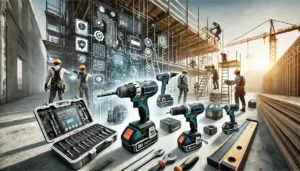Power tools have evolved so much in the past 100 years. One hundred years ago, these tools were hand-operated but now they can be classified as sophisticated machines. Tools like cordless drills, circular saws, and even sanders have changed home maintenance tools for the better. Industries like construction, manufacturing, automotive, and home improvement have greatly benefitted too. One of many shifts that has drastically changed the improvement of a task is the shift from corded to cordless power tools. Advancement in mobility, convenience, and efficiency are the biggest reasons for the shift in tools. This article talks about how power tools have changed over the years and focuses more on technological change.
The Early Days of Electric Power Tools
Electric power tools originated in the later half of the 19th century. The first electric drill was created in 1895. This drill eased the labor heavy drilling process. With the invention of these tools, a variety of industries could function at a more controlled pace because the workforce required manual effort for every basic task. Other power tools like saws and grinders were also created a few decades later. All these tools required a constant connection with an electrical outlet, making them corded tools.
At that time, the most efficient and dependable tools were corded, unfortunately, they came with limitations when it came to movement. Because of their dependence on power sources, working outdoors or in remote locations became extremely hard to do.
The Rise of Cordless Tools
The introduction of the first cordless drill by Black & Decker in 1961 was a major breakthrough. It was the most exciting development in the industry since the power tool industry had greatly benefitted from it. The drill, which utilized a nickel-cadmium (NiCad) battery, gave its users unprecedented liberty of movement as they were no longer constrained to electrical outlets. Even though early cordless tools had limitations of shorter battery life as well as longer recharge times, they significantly increased the flexibility of performing tasks and helped boost productivity.
As the decades went by, more and more people began to utilize cordless tools as the technology surrounding batteries improved, which made using the tools far more convenient. These tools also signified a large shift in the industry as workers began to realize the ease of utilizing these types of tools.
Advancements in Battery Technology
One major driver of the evolution of cordless power tools was the improvement in battery technology. The cordless tools market was turned upside down with the launch of lithium-ion (Li-ion) batteries in the 1990s. Along with the older NiCad batteries, Li-ion batteries offered several advantages such as being lighter, longer run times, and faster recharges. These changes made tasks that were previously difficult to manage with tools much simpler, which made Li-ion the go to option for power tools.
Li-ion batteries were high in power and ultra-efficient, allowing cordless tools to perform at demanding level such as Heavy duty drilling, cutting, and sanding without the drawbacks that were often present in earlier models. As a result, cordless power tools became more dependable and began to take over in place of corded tools in various industries.
Integration of Brushless Motors
Developing brushless motors marked yet another important development in the evolution of power tools. Modern power tools have seen great strides since the advent of brushless motors, which are defined by their distinctive attribute of not utilizing brushes for power transfers to the motor’s rotor. Addressing several problems in one go, the development tremendously increased tools’ efficiency, decreased generated heat, and prolonged the lifespan of power tools. Substantially more energy-efficient, brushless motors in comparison allow for battery life that is considerably longer, in addition to a more consistent output of power during usage.
Not only did brushless motors improve the functionality of cordless tools, they also enhanced the entire tool system’s capabilities. Alongside more advanced battery systems, power tools operating on batteries began to outperform or at the very least match the performance of their corded counterparts. Construction and automotive repair industries have greatly benefited from this advancement due to the tools’ reliability and power.
Emerging Innovations and New Directions
The clear dividing line between corded and cordless power tools has yet again shifted. The newer cordless tools continue to increase in popularity due to their power, performance, and advanced battery systems which surpass the competition of their corded counterparts. The battery technology used within power tools is evolving as well, with an increasing amount of fast-charging batteries and high voltage systems being incorporated for extended operating times and boosted efficiency.
In addition, tools are becoming smarter with the addition of Bluetooth technology and sensors. These features enable users to track performance, battery life, and diagnostic information concerning the overall health of the tool. In the future, the use of smart technologies is predicted to expand, resulting in treated power tools that are more efficient, user friendly, and responsive to the needs of the operator.
As technology progresses, the advancement of energy storage technologies, like solid-state batteries, will most likely increase the power and endurance of cordless working tools. Moreover, the emergence of AI and machine learning can create power tools that adjust and adapt to the behavior of the user, making the tools more effective for the specific task being performed. The creative possibilities that lie in these concepts will reshape the construction industry, not only impacting the performance of power tools but also increasing the safety and efficiency at work.
Conclusion
There’s an ongoing focus on increasing the convenience, power, and performance of power tools. The move from corded to cordless drills marked a huge step forward. Power tools are now, more than ever, used correctly with battery powered drills and tools now commonplace throughout the industry’s landscape. Technologies such as smart batteries, which alter the way power tools are integrated within a worksite, further promises advancements in efficiency and versatility. In short, the future of power tools is in great condition.
The shift to cordless tools certainly marked a new era in the importance of flexibility with the improved productivity it brought in industries as well as construction and even home repairs. As technology progresses, the new generation of power tools will likely improve workplace safety and productivity even further.










